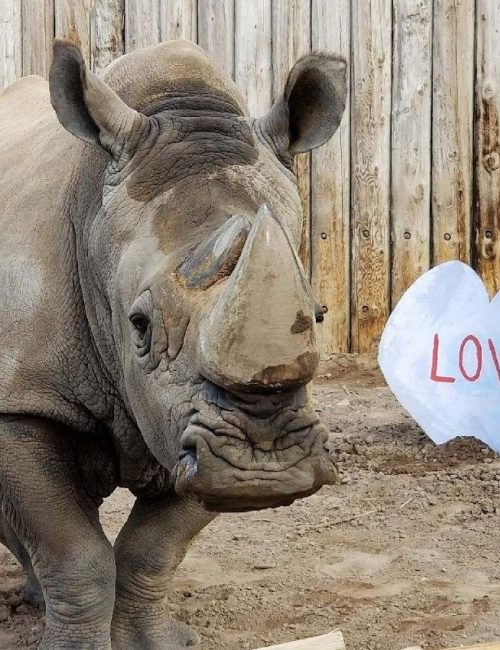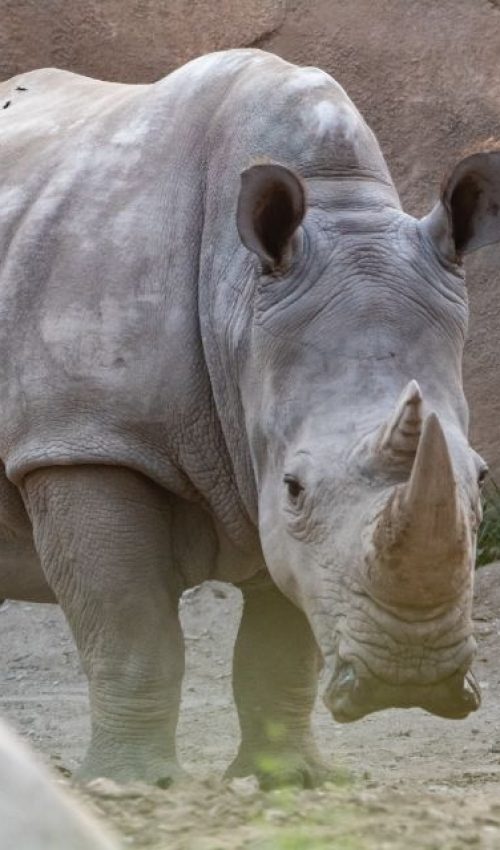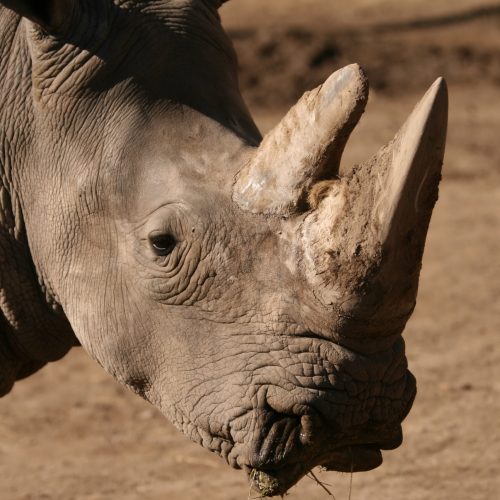

Geriatric Giants
Caring for sibling southern white rhinos.
Remembering George
Our hearts were full as Hogle Zoo said goodbye to geriatric giant George. Surrounded by his dedicated care and veterinary teams, George (48) was humanely euthanized on December 18, 2024, after his health declined. In early 2024, George was diagnosed with rapidly advancing cancer in his rear left leg. Our zoo’s veterinarians consulted with human and veterinary oncologists to consider various treatment options. However, no long-term treatment options were available based on his age, size, and thick skin.
-Lauren LeCoque, Supervisor, High Desert Oasis

Utah’s Hogle Zoo has been home to half-sibling southern white rhinos George (male) since 1977 and Princess (female) in 1980. At 48 and 45 years old, George and Princess are some of the longest residents at Utah’s Hogle Zoo. They are considered geriatric members of their species and are nearly the oldest southern white rhinos at any Association of Zoo and Aquariums (AZA) zoo. Our team works with AZA zoos across the rhinoceros species advisory group to learn the latest advances in geriatric veterinary care.

Where is Princess?
You may not see Princess during your visit because she may be indoors resting, receiving treatments, or being pampered by her keepers, which are important parts of her advanced geriatric care.
We love how Princess has been part of your zoo visits and memories for many generations and understand the disappointment in not being able to visit her. Thank you for being understanding as we support this incredibly loved member of our zoo family.
-Megan Pushie, senior animal keeper, High Desert Oasis
Geriatric giant
In their natural habitat, rhinos can live up to 20-25 years old due to predators and poaching. But, with exceptional health care and no predators, southern white rhinos in human care can live into their mid-40s, leading them to experience natural ailments of old age.
The animal care team describes 3,900-pound Princess as inquisitive and motivated. Since she is in her golden years, her medical needs are changing, and her size makes care even more challenging.
Providing whole-life care
Hogle Zoo’s mission is to create champions for wildlife, and we consider ourselves lucky to have incredible animals like Princess under our care. As champions for wildlife, we know how important zoos and the connections made here can be to achieving our vision of a world where humans and wildlife thrive together. We also know that, in exchange, we must provide each animal under our care with the individual attention it needs to thrive.
Princess receives extensive specialized care as she enters her golden years.
- On July 1, 2024, our team observed Princess displaying abnormal behaviors. Based on her behavior and symptoms, which appeared to be neurologic in nature, we believe she had a seizure. Princess experienced one more seizure in November 2024. We consult with rhino experts and treat her seizures with twice-daily medication and modified care.
- Princess voluntarily participates in laser therapy to treat arthritis in her left ankle. This non-invasive treatment stimulates blood flow and reduces inflammation.
- We provide soft substrate beds, and our rhino barn has special rubberized flooring. Rhinos can sleep standing up or lying down. We see Princess choosing to lay down to rest as she ages—understandable given that her feet have supported her 3,9000-pound body for more than 45 years!
- Despite rubberized flooring in indoor bedrooms and tilled dirt in outdoor habitats, older rhinos are prone to pressure sores. Due to the thickness of pachyderm skin, it takes much longer for wounds to close. The rhino care team monitors and treats pressure sores daily, including laser and hydrotherapy. For pressure sore treatment, you may see silver wound spray, bandages, or ointments on Princess.
- Like human seniors, rhinos will experience weight changes, muscle atrophy, and a general slowing down. Princess’ care teams monitor her body condition and health daily, providing supplements, medication, and treatment as needed.
- Princess has a one-of-a-kind eye mask to protect her eyes as she deals with the effects of seasonal allergies. See her fly mask →
- Princess receives special nutrition, like pre-cut hay, because her teeth have worn down with age. We have shifted away from sugary fruits and use high-fiber greens like celery and lettuce, which are easier on Princess’ elderly digestive system.
- Princess enjoys mud-wallowing areas, and we help her apply mud to her skin, keeping it moisturized and protected from the sun and bugs.
- Our team holds regular training and drills to prepare us if Princess needs assistance standing up.
- A board-certified veterinary ophthalmologist diagnosed Princess with small cataracts, leading to decreased depth perception and night vision.
Health checks
George and Princess voluntarily participate in their health monitoring and veterinary treatments thanks to a long, trusting relationship with their care team. Animal training at Hogle Zoo is on the animals’ terms. They choose to interact, build trust with the trainers, and become active participants in their veterinary care.
Training behaviors like opening a mouth, allowing us to touch different parts of their bodies, or voluntarily allowing us to draw blood helps us assess health and respond quickly to any needs. By tracking blood and urine samples, we monitor George and Princess’ kidney values, as kidney disease is common in geriatric rhinos.
The rhinos enjoy eating part of their breakfast in an area where keepers can examine them closely. In the morning, we also do laser therapy, treat pressure sores, and administer medicines.

About southern white rhinos
Southern white rhinos live in the grasslands, savannas, and shrublands of South Africa, Botswana, Kenya, Namibia, Eswatini, Zambia, Zimbabwe, and Uganda. They are the third largest land animal after the two species of elephants. White rhinos have two horns and are called square-lipped rhinos because of their wide, straight upper lip for “mowing grass.”
Rhino conservation
At the start of the 20th century, more than 500,000 rhinos shared the planet with us. Today, roughly 26,000 rhinos remain. Four of the five rhinos are threatened with extinction; three are critically endangered and could become extinct within our lifetime. Rhinos are threatened by wildlife poaching, habitat destruction, and human conflict.
Utah’s Hogle Zoo partners with the International Rhino Foundation to encourage anti-poaching efforts, protect rhinos, and support communities. Just by visiting Hogle Zoo, part of your ticket goes towards conservation efforts around the globe.
Animal wellbeing
Saving animals in the wild starts with the wellbeing of the animals under our care. We are proud to be accredited by the Association of Zoos and Aquariums, committing ourselves to the highest animal care standards. Every day, a dedicated team of zoo experts, including veterinarians, keepers, and operations, works together to help George and Princess experience positive wellbeing during their golden years. While we don’t know how much time we have with them, we will ensure they are happy and comfortable for as long as possible.

